
These slides contain the vocabluary from the Virginia Department of Education.
- Subject:
- Cybersecurity
- Material Type:
- Lecture Notes
- Author:
- Erika Coble
- Date Added:
- 06/26/2022

These slides contain the vocabluary from the Virginia Department of Education.
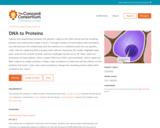
Explore the relationship between the genetic code on the DNA strand and the resulting protein and rudimentary shape it forms. Through models of transcription and translation, you will discover this relationship and the resilience to mutations built into our genetic code. Start by exploring DNA's double helix with an interactive 3D model. Highlight base pairs, look at one or both strands, and turn hydrogen bonds on or off. Next, watch an animation of transcription, which creates RNA from DNA, and translation, which 'reads' the RNA codons to create a protein.

These slides contain the vocabulary from the Virginia Department of Education for this strand.
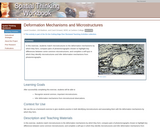
In this exercise, students match microstructures to the deformation mechanisms by which they form; compare pairs of photomicrographs chosen to highlight key differences between some common microstructures; and complete a self-quiz in which they identify microstructures and infer deformation mechanisms from photomicrographs.

Determine the dew point temperature for your classroom through a hands-on experiment. Use humidity and temperature probes to investigate the temperature at which it would rain in your classroom! Learn about water density and the conditions necessary to produce fog or rain.

Movement of ions in and out of cells is crucial to maintaining homeostasis within the body and ensuring that biological functions run properly. The natural movement of molecules due to collisions is called diffusion. Several factors affect diffusion rate: concentration, surface area, and molecular pumps. This activity demonstrates diffusion, osmosis, and active transport through 12 interactive models.
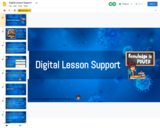
Theresa Sincere-Eastman of Loudoun created this presentation for teachers moving to online teaching. It has several tips and links to supportive resources.

This a foldable that can be used for teaching the characteristics of direct and inverse variation.

The interactions of electrons with matter have great explanatory power and are central to many technologies from transistors, diodes, smoke detectors, and dosemeters to sophisticated imaging, lasers, and quantum computing. A conceptual grasp of the interactions of electrons in general allows students to acquire deeper understanding that can be applied to a very broad range of technologies.

Use a series of interactive models and games to explore electrostatics. Learn about the effects positive and negative charges have on one another, and investigate these effects further through games. Learn about Coulomb's law and the concept that both the distance between the charges and the difference in the charges affect the strength of the force. Explore polarization at an atomic level, and learn how a material that does not hold any net charge can be attracted to a charged object. Students will be able to:
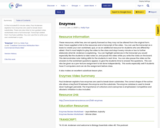
In the included11.5 minute video, Paul Andersen explains how enzymes are used to break down substrates. There are also links to two guided notes worksheets and a full transcript.
Transcript added from YouTube subtitles. You can use this to write your own worksheet or quiz.
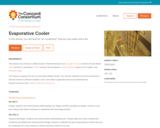
Explore the concept of evaporative cooling through a hands-on experiment. Use a wet cloth and fan to model an air-conditioner and use temperature and relative humidity sensors to collect data. Then digitally plot the data using graphs in the activity. In an optional extension, make your own modifications to improve the cooler's efficiency.
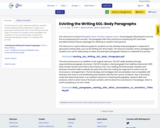
This resource is a quick reference guide for students as they develop body paragraphs in response to persuasive writing tasks, such as the Writing SOL Short Paper. The resource includes various strategies that students can use for elaborating on ideas and exemplar paragraphs based on a released SOL prompt.
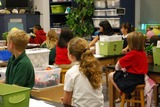
This activity is designed to be a self-paced activity to review students on the parts of Experimental Design while at home or in the classroom. There is a simple experiment for the students to complete to generate and collect data and a second example in which they design their own experiment and collect data. They are then led through the process of analyzing their data and writing a conclusion.
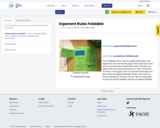
This a foldable of the rules to simplify expressions with exponents.

The Facilitating online communities ourse has been developed by staff in the Educational Development Centre of Otago Polytechnic and is designed to help both formal and informal learners access and interpret models, research and professional dialog in the facilitation of online communities. After completing this course people should be confident in facilitating online and/or be able to critique and offer advice to other people in the facilitation of online communities.
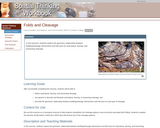
In this exercise, students explore the geometric relationship between bedding/cleavage intersections and fold axes for axial planar, fanning, and transecting cleavage.
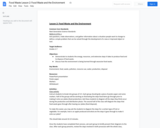
Objectives:
- Demonstrate to students the energy, resources, and extensive steps it takes to produce food and to dispose of food waste.
- Discuss how the environment is being harmed through excessive food waste.

In the engage section of the 5Elesson, students are introduced to the role of fossils as evidence of evolution and evolutionary relationships by watching a videos about the discovery of Lucy and Ardi and consider what type of information that they can gain from skull fossils. Students will then explore features of skulls from human ancestors and the modern day Homo sapien. After measuring skull to cheekbone ratios, students will create a graph to compare various species. Several interactives are provided to explain fossils, skeletal evidence for human evolution, and phylogenetic trees. Then, students will apply their skills of analyzing data about anatomical similarities and genetic information to depict evolutionary relationships between organisms using cladograms. To evaluate student understanding, students will complete an evolutionary relationships CER.

In this activity, students study gas laws at a molecular level. They vary the volume of a container at constant temperature to see how pressure changes (Boyle's Law), change the temperature of a container at constant pressure to see how the volume changes with temperature (Charles’s Law), and experiment with heating a gas in a closed container to discover how pressure changes with temperature (Gay Lussac's Law). They also discover the relationship between the number of gas molecules and gas volume (Avogadro's Law). Finally, students use their knowledge of gas laws to model a heated soda can collapsing as it is plunged into ice water.